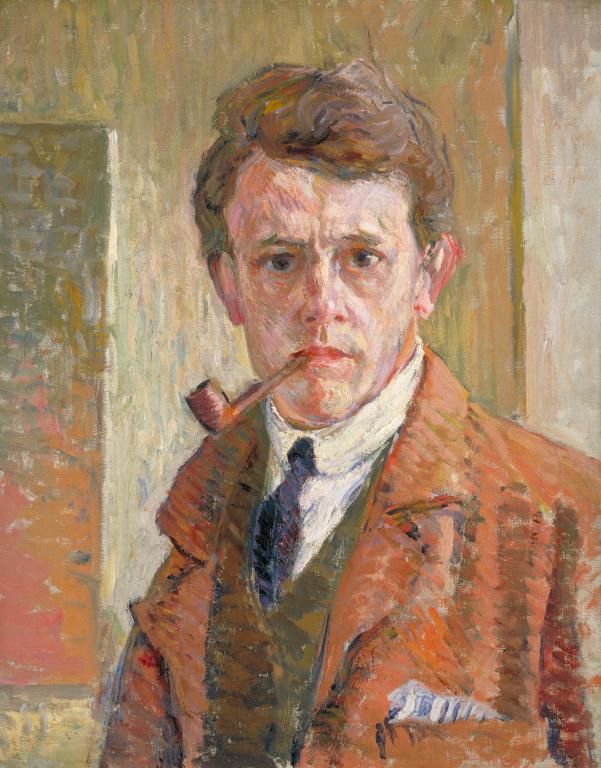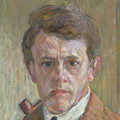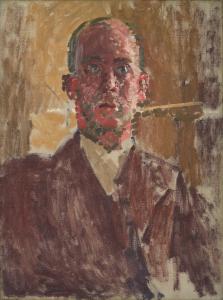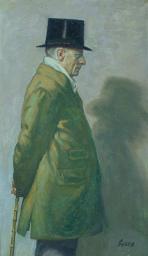James Bolivar Manson Self-Portrait c.1912
James Bolivar Manson,
Self-Portrait
c.1912
This self-portrait was painted when Manson was in his early thirties, around the time he joined the staff of the Tate Gallery as Chief Clerk. Executed in broken touches of colour, it shows Manson in a pose of artistic bohemianism, with ruffled painting coat, pipe hanging from his lips, and stern gaze looking out at the viewer.
James Bolivar Manson 1879–1945
Self-Portrait
c.1912
Oil paint on canvas
508 x 397 mm
Inscribed by the artist ‘J. B. Manson ptd. about 1912’ on stretcher
Presented by D.C. Fincham 1938
N04929
c.1912
Oil paint on canvas
508 x 397 mm
Inscribed by the artist ‘J. B. Manson ptd. about 1912’ on stretcher
Presented by D.C. Fincham 1938
N04929
Ownership history
Purchased at Wildenstein & Co., London, by David C. Fincham in 1937 and presented anonymously to Tate Gallery 1938.
Exhibition history
?1925
?Pictures by J.B. Manson, Ruskin Galleries, Birmingham, until July ?1925 (1, as ‘Portrait of the Artist’).
1930
?The Camden Town Group, Leicester Galleries, London, January–February 1930 (40, as ‘Self-Portrait 1912’).
1934
Wednesday–Thursday Gallery, London, Spring 1934 (catalogue untraced).
1937
Exhibition of Paintings by J.B. Manson, Wildenstein & Co., London, October–November 1937 (32).
1951
The Camden Town Group, Southampton Art Gallery, June–July 1951 (98).
1961
Camden Town Group: Fiftieth Anniversary Exhibition, The Minories, Colchester, September 1961 (51).
1979
James Manson 1879–1945, New Grafton Galleries, London, March 1979 (36).
1997
Characters and Conversations: British Art 1900–1930, Tate Gallery, Liverpool, March 1996–April 1997 (27, reproduced).
References
1934
Douglas Goldring, ‘Artists and Pictures’, Studio, vol.107, January–June 1934, p.161 reproduced.
1964
Mary Chamot, Dennis Farr and Martin Butlin, Tate Gallery Catalogues: The Modern British Paintings, Drawings and Sculpture, vol.2, London 1964, p.426.
1988
Laura Wortley, British Impressionism: A Garden of Bright Images, London 1988, reproduced p.242.
Technique and condition
Self-Portrait is painted in artists’ oil paints on a pre-primed stretched canvas, supplied by the artists’ colourman P. Shea, who was used by several Camden Town Group artists. The canvas is fine, plain-weave linen and has been prepared with sizing and a white, probably oil-based, primer. Small areas of priming and paint have lifted from the canvas, probably due to an inherent instability in the support, which may be a so-called ‘shrinker’.1
Manson began his painting by drawing in thinned blue paint directly on to the priming, apparently without any preliminary underdrawing. The distinctive use of thinned blue paint for the underdrawing was associated with post-impressionist technique and was popularly adopted by English artists at the time (see also Tate T02260 and T00164). The paint is brushed on briskly in linear strokes that describe the forms and impart lively shimmering colour. Some areas, such as the background, are summarily executed, leaving patches of priming visible through the broken brushwork and around the edges. The head and collar are most densely worked, the artist applying successive strokes of soft tints heightened with accents of purer colour, building up into thicker layers as he struggled to resolve the portrait. There are several areas of reworking, the sitter’s right side and the reinstatement of the background to define the contour of the jacket, for example, and additional detail added in the final stages, such as the jacket pocket and handkerchief. The painting is unvarnished leaving a matt surface characteristic of paint that has been thinned only with solvent without the addition of painting medium.
Roy Perry and Sarah Morgan
August 2004
Notes
A term used to describe a characteristic type of canvas, usually associated with commercially prepared canvas supports of the late nineteenth and early twentieth centuries. The sizing is applied in such a way that it does not really impregnate the fibres but forms an even layer on top of the canvas, thus forming a weak bond. This allows the canvas to expand and contract in response to changes in temperature and humidity, to a greater extent, creating an unstable support structure.
How to cite
Roy Perry and Sarah Morgan, 'Technique and Condition', August 2004, in Robert Upstone, ‘Self-Portrait c.1912 by James Bolivar Manson’, catalogue entry, July 2009, revised by Helena Bonett, February 2011, in Helena Bonett, Ysanne Holt, Jennifer Mundy (eds.), The Camden Town Group in Context, Tate Research Publication, May 2012, https://wwwEntry
Manson was in his early thirties when he painted this self-portrait. It shows him in a pose that combines alertness and a very direct gaze with an assumed aspect of informality by depicting himself with a pipe in his mouth. This character of artistic bohemianism is reinforced by his unstructured jacket, which is probably his painting coat. The portrait has the appearance of having been made while looking in a mirror, with adjustments made later. It is painted in a version of impressionism, with broken touches of paint and colour. With his friend Lucien Pissarro, Manson believed strongly that the impressionist technique and theory developed by Lucien’s father Camille was the ideal style of art. Like Lucien, he had misgivings about the more radical direction the London avant-garde was taking away from such principles, although he tried to hold the Camden Town Group together and later ensure the plurality of the London Group that succeeded it.1
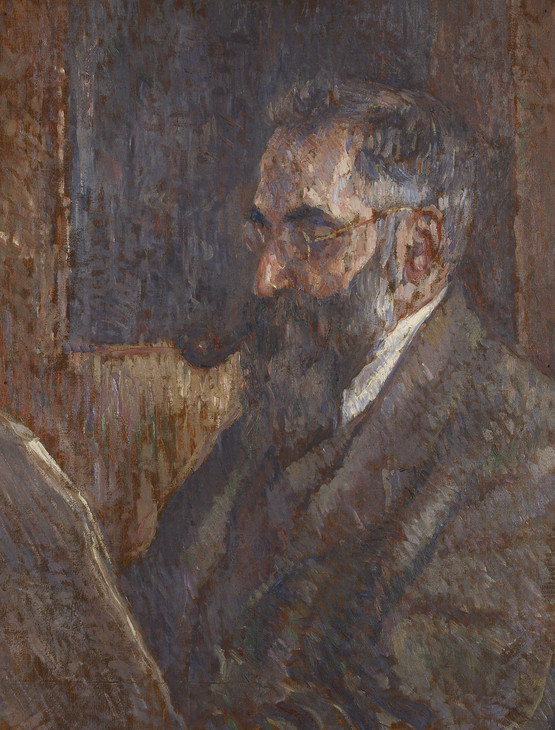
James Bolivar Manson 1879–1945
Lucien Pissarro Reading c.1913
Oil paint on panel
450 x 350 mm
Ashmolean Museum, Oxford
© Estate of James Bolivar Manson
Photo © Ashmolean Museum, Oxford
Fig.1
James Bolivar Manson
Lucien Pissarro Reading c.1913
Ashmolean Museum, Oxford
© Estate of James Bolivar Manson
Photo © Ashmolean Museum, Oxford
When Manson had moved to Paris in 1903 to study at the Académie Julian, his friend Samuel Halpert had painted a half-length portrayal of him in the typical Whistlerian style of the time.6 Manson had first become affiliated with the Fitzroy Street Group through Pissarro in late 1910. Shortly after this he depicted himself in the group’s shared studio in Self-Portrait. The Fitzroy Street Studio c.1911 (Fine Art Society).7 In contrast to the close-up view in the Tate work, this self-portrait presents an almost full-length depiction of the artist seated in a chair, looking young and thin in a rather outsized suit. Manson’s poses in the Halpert portrayal and the c.1911 self-portrait appear hesitant and effeminate in comparison to the masculine, uncompromising stare of the Tate self-portrait. It is interesting to compare this work with the portraits and self-portraits of his fellow Camden Town Group colleagues from this period, including those of Charles Ginner, Spencer Gore and Robert Bevan, which also portray a form of masculine bohemianism (figs.2–4).8 Manson also made a later self-portrait that is now in Southampton City Art Gallery, purchased from the artist in 1937 and probably made around then.
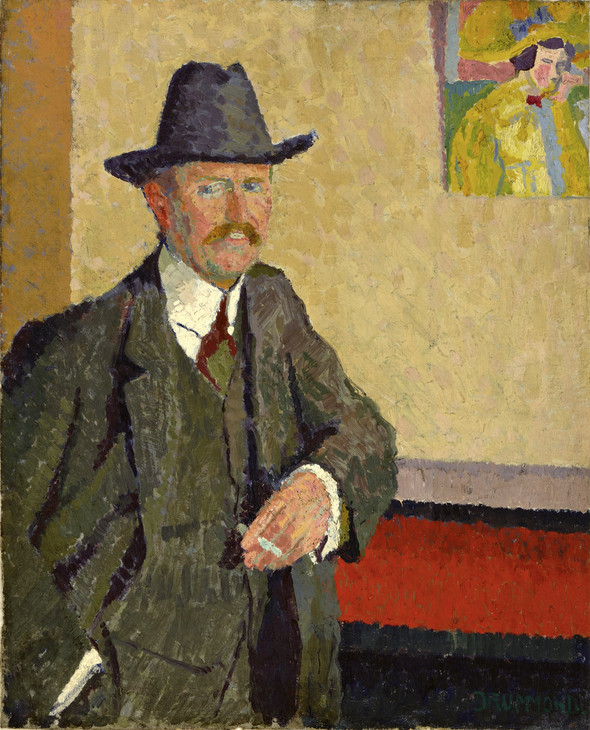
Malcolm Drummond 1880–1945
Charles Ginner 1911
Oil paint on canvas
603 x 490 mm
Southampton City Art Gallery
© Estate of Malcolm Drummond
Photo © Southampton City Art Gallery, Hampshire, UK / The Bridgeman Art Library
Fig.2
Malcolm Drummond
Charles Ginner 1911
Southampton City Art Gallery
© Estate of Malcolm Drummond
Photo © Southampton City Art Gallery, Hampshire, UK / The Bridgeman Art Library
Manson joined the staff of the Tate Gallery as Chief Clerk in 1912, around the time this picture was painted. He was Assistant Keeper 1917–30, and from 1930 until 1938 he led the gallery as director. Manson’s portrait was presented by David Fincham, one of the gallery’s Assistant Keepers, who was on friendly terms with his director. In a letter to the Tate in 1957 he outlined the circumstances of its acquisition:
The Manson self portrait was exhibited at a gallery in Knightsbridge in 1936 or 1937. The gallery was started by the Hon Mrs Cochrane & closed down when the war broke out. I think it was a one-man show – at any rate there were a number of Manson’s pictures there. I bought it from the exhibition, and presented it anonymously during J.R.[othenstein]’s Directorship when the dust raised by Manson’s retirement had died down. It was painted to the best of my recollection between 1913 & 1915.9

Spencer Gore 1878–1914
Self-Portrait 1914
Oil paint on canvas
410 x 305 mm
National Portrait Gallery, London
Photo © National Portrait Gallery, London
Fig.3
Spencer Gore
Self-Portrait 1914
National Portrait Gallery, London
Photo © National Portrait Gallery, London

Robert Bevan 1865–1925
Self-Portrait c.1914
Oil on canvas
457 x 356 mm
National Portrait Gallery, London
Photo © National Portrait Gallery, London
Fig.4
Robert Bevan
Self-Portrait c.1914
National Portrait Gallery, London
Photo © National Portrait Gallery, London
Fincham may have been misremembering from which gallery he had bought it. Manson’s solo exhibition was held at Wildenstein’s in Bond Street in October–November 1937, and included a work listed as Self-Portrait (32), which is almost certainly the Tate painting. Fincham’s presentation of the picture to the Tate Gallery in 1938 was designed to mark the tenure of Manson’s directorship. In 1932 the gallery had accepted the gift of an oil by Stephen Bone of Manson’s predecessor, Charles Aitken (Tate N04618), establishing the precedent of marking former directors by the acquisition of a portrait. Fincham’s mention of waiting until ‘the dust raised by Manson’s retirement had died down’ is a reference to the fallout from Manson effectively being forced out of his post and into early retirement after causing a diplomatic incident in Paris by drunken behaviour.
Robert Upstone
July 2009
Revised by Helena Bonett
February 2011
Notes
Lilian in Miss Odell’s Garden, reproduced in The Painters of Camden Town 1905–1920, exhibition catalogue, Christie’s, London 1988 (86).
NPG 5731, reproduced at National Portrait Gallery, London, http://www.npg.org.uk/collections/search/largerimage.php?search=sp&sText=halpert+manson&firstRun=true&rNo=0 , accessed 21 February 2011.
For more on artists’ self-portraits, see Andrew Stephenson, ‘Questions of Artistic Identity, Self-Fashioning and Social Referencing in the Work of the Camden Town Group, c.1905–14’, The Camden Town Group, Tate 2011, http://www.tate.org.uk .
Related biographies
Related essays
Related catalogue entries
How to cite
Robert Upstone, ‘Self-Portrait c.1912 by James Bolivar Manson’, catalogue entry, July 2009, revised by Helena Bonett, February 2011, in Helena Bonett, Ysanne Holt, Jennifer Mundy (eds.), The Camden Town Group in Context, Tate Research Publication, May 2012, https://www

